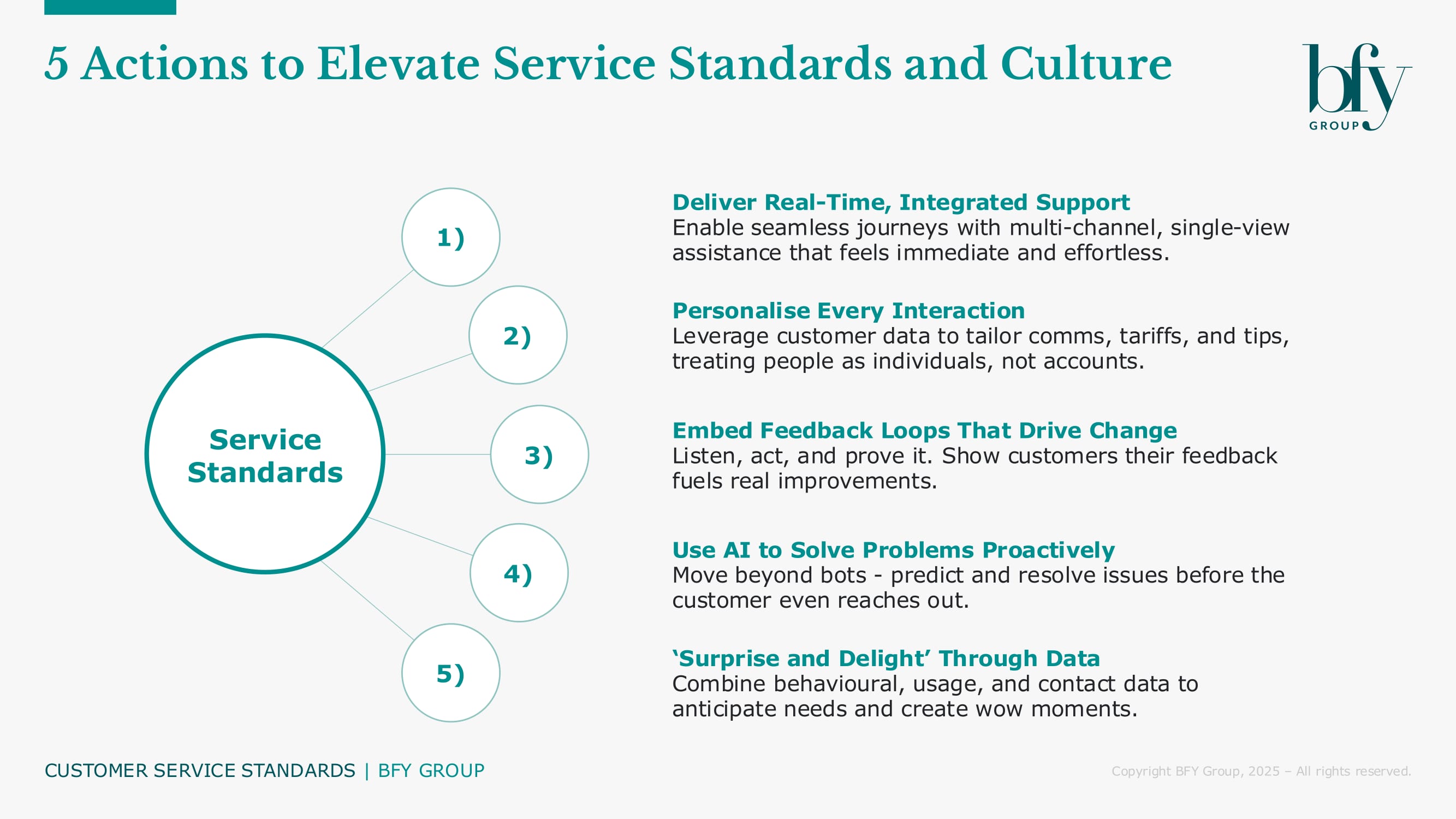With Ofgem’s ambitious vision for a leading, customer-centric energy sector clearly set, suppliers can get ahead of the curve by acting now – capitalising on the added benefit of market gains and lower operational costs.
Ofgem is striving for energy to become the UK’s best sector for customer service. Their mission reflects a growing recognition of customer experience’s importance in fostering trust, loyalty, and satisfaction, within a sector that’s faced historic criticism for its service standards.
It’s clear that existing service standards won’t be deemed good enough, and continued headlines of rising bills and record-breaking debt levels will only support the case for change.
The realisation of Ofgem’s vision depends on how quickly and effectively suppliers can embrace customer-centric approaches. It’s only with this commitment that the perception, and reception, of customer service can be fundamentally changed.
We’ve explored areas where positive change can be targeted below, while acknowledging the journey and level of maturity will be different across all suppliers.

Actions to transform service standards and build a customer-centric culture
Introduce real-time, multi-channel integrated assistance
In today’s fast-paced world, customers expect immediate solutions to their problems. Real-time assistance through telephony channels isn’t real-time enough anymore, and whilst newer service channels have become commonplace (live chat, social media, help bots) - these don’t yet feel established enough to offer a complete alternative to calling, particularly for more complex matters.
Further effort is needed in augmenting these channels to be able to service more challenging areas, as well as ensuring a complete ‘single view’ integration for customer service agents. Teams can then see that a customer has previously tried channel X or Y, before eventually calling, and actively help the customer - rather than them repeatedly explaining the background of their issue.
Customer experience can be significantly enhanced by having the right channels in place, with further development on a fully integrated, single-view of the customer’s journey through contact points. Aligning this with a robust customer service strategy, that prioritises quick response times and accessibility, will help to create a sense of reliability and trustworthiness amongst customers.
Make it personal
One-size-fits-all approaches to customer service are no longer sufficient. To lead the way in customer-centricity, energy providers have opportunities to leverage customer data and create highly personalised engagement strategies. This could include tailored communication based on a customer’s energy usage patterns, to suggest alternative tariffs or personalised energy-saving tips, especially as Market-wide Half Hourly Settlement (MHHS) approaches.
By treating customers as individuals rather than account numbers, companies can foster deeper connections and create a competitive advantage via servicing, that differentiates from competitors.
Create effective feedback loops to enhance loyalty
Regularly soliciting customer feedback through surveys, focus groups, or direct outreach can provide valuable and continuous insights into areas needing improvement. However, for a service culture to be ‘best in class’, this feedback must be translated into iterative change.
Moreover, demonstrating that customer feedback is taken seriously, by implementing changes based on their suggestions, can significantly enhance customer loyalty.
Here’s one example of how we’ve seen feedback loops lead to tangible change:
- Feedback Loop: One energy supplier established a feedback loop through customer service interactions, and by analysing call data and customer satisfaction surveys, they identified that long wait times were a significant pain point.
- Change: They invested in AI-driven chatbots and an improved call routing system, also implementing a follow-up survey post interaction, allowing for continuous monitoring of customer satisfaction.
- Impact: Average wait times were reduced by 30%, leading to a noticeable increase in customer satisfaction scores and reduced complaints about customer service, demonstrating how proactive engagement with feedback can lead to substantial improvements.
Improve and integrate AI to enable proactive problem solving
Chatbots and other AI-driven solutions are becoming more common in customer service, but require a continuous improvement focus to ensure the correct iterative learnings are made. Regular evaluation and updates based on customer interactions will help to maintain the effectiveness of these solutions, and enable full integration capability as previously mentioned with other servicing channels.
This means when a query is either too difficult, not previously encountered, or proactively considered as a journey that shouldn’t be handled by AI (e.g., bereavement notifications or other sensitive areas), a ‘continued flow’ handoff to a servicing agent can happen, without disrupting the customer experience and servicing journey.
Going further, by having fully integrated AI capability within the customer account, there’s an opportunity for businesses to get ahead of the competition by moving from reactive query resolution, to proactively solving customer problems. Fully integrated AI bots or assistants could reach out to customers via their online account email, or directly via the app to offer preventative solutions, based on activity identified from the individual customer’s usage, activity, or contact. Mapping of key activities associated with known negative customer journeys can enable the right proactive steps to be automatically taken.
Use data to ‘surprise and delight’ the customer
Future customer experience approaches need to be more data driven than anything historically encountered.
Currently, CSAT and post engagement surveys give valuable insight but only really offer a fraction of the true customer voice and experience. When you add in contact data (number of contacts, reasons, channel usage, time of contact), web or app usage, geographical location, and energy specific data such as consumption and payment information, opportunities exist to see the ‘real world view’ of customer behaviour. This view can enable AI to predict how satisfied the customer is going to be, without even needing to ask them. By flipping your customer engagement strategy to become fully proactive and targeted, you can ‘surprise and delight’ the customer, always being on the front foot before they need to ask for help.
Empower customer-facing teams to uphold exceptional standards
A customer-centric culture starts from within. Empowering employees through training, resources, and a supportive work environment can inspire your teams them to deliver the exceptional service that is needed to be ‘best in class’.
Ask these questions to reflect on how your service culture shapes up:
- What % of people are having regular one-to- ones and development conversations with their managers?
- Do we have high absence and high staff turnover, and how can we limit this?
- Are we nurturing a positive work culture at every level?
- Is there potential to reduce recruitment spend by developing our current workforce?
- Could we reduce cost to serve through a broader, upstream focus on leadership capability?
Through immersive coaching, we’re currently helping a large energy retailer to transform service standards, delivering over 2000 sessions to 350 customer-focused leaders. This ILM-accredited programme is proven to transform service standards, encouraging high-performance and continuous improvement. Previously, at another large supplier, the programme has enabled multi-£m savings by reducing cost to serve and operating costs, while enhancing customer satisfaction (+34 NPS uplift) and employee engagement (170% increase).
Lead the way to ‘best in class’
Ofgem’s vision for the energy sector to become the best customer service culture in Britain is an opportunity for suppliers to rethink their approach. Improving from existing standards to ‘best in class’ will require a clear strategy for investment and new thinking.
A commitment to these principles will not only elevate customer satisfaction, but also contribute to a more sustainable and trustworthy energy landscape. As the sector evolves, it’s clear that those who prioritise and invest in customer experience now can lead the way in market gains, and ultimately reduce operational spend through happier and better served customers.
Contact Jonathan Paton for more on how you can capitalise on these opportunities, build the case for investing in them, and drive the charge in creating a leading customer-centric culture.
Jonathan Paton
Senior Manager
Jon specialises in Customer Operations leadership, customer contact, and operational service delivery transformation/improvement.
View Profile

